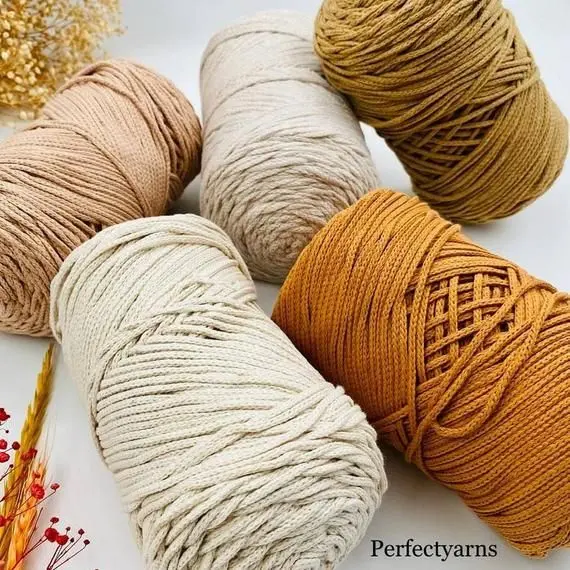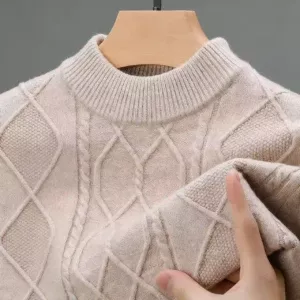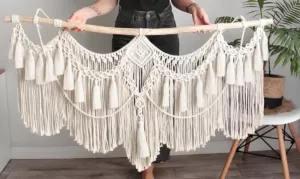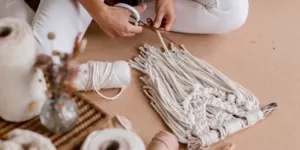Can I Use Cotton Yarn for Macrame – Macrame has been a beloved craft for centuries, with its intricate knots and patterns creating everything from wall-hangings to plant holders. It involves knotting cords or string in various combinations to make decorative or functional items. But when we think of macrame, we commonly envision thick, twisted cords that form the vintage boho-chic decor that’s experienced a resurgence in popularity. But for many crafters looking to dive into this knotty affair, one question often comes up: Can I Use Cotton Yarn for Macrame?
The Tangled Tale of Macrame
Macrame originated in the 13th century, with Arabic weavers knotting excess thread on hand-loomed fabrics into decorative fringes on towels, shawls, and veils. The craft eventually spread through Europe and became popular in the Victorian era before experiencing a free-spirited revival in the 1970s. Today, macrame continues to charm DIY enthusiasts with its Zen-like process of tying knots and its visually pleasing results.
Weaving Through Common Macrame Materials
When one pictures a macrame wall hanging, you can almost feel the coarse texture of the traditional macrame rope. The materials commonly associated with macrame include:
- Jute: A natural and durable fiber that gives a rustic appeal.
- Hemp: Known for its strength and sustainability, hemp lends an organic look to macrame creations.
- Macrame Cord: A specially made cord, often made from cotton or a poly-cotton blend, that is designed to hold knots securely.
- Polyester/Cotton Twine: A blend that offers more versatility and vibrant colors, while also being strong.
These various fibers each bring their own unique textures and strengths to macrame, affecting the look and endurance of the final piece.
Introducing the Cotton Yarn Proposition
Now we turn our focus to a fiber beloved by knitters and crocheters worldwide—cotton yarn. Known for its softness, versatility, and a wide array of colors, cotton yarn is a staple in many yarn stashes. It’s absorbent, machine-washable, and generally gentle on the skin, making it a favorite for wearable and household textile projects. But does it have a place in the world of macrame?
Can the same yarn that’s been turned into countless sweaters and baby blankets hold its own when tied into knots? The answer isn’t a simple yes or no, as it depends on various factors, like the type of cotton yarn and the intended project. In the upcoming sections, we explore the ways cotton yarn can weave its way into your macrame pursuits and when it might be better to stick with more conventional macrame materials.
Stay tuned as we unravel the mysteries of using cotton yarn in macrame and provide you with tips and tricks to successfully incorporate this versatile yarn into your next knotty endeavor!
When to Use Cotton Yarn in Macrame
Macrame enthusiasts often face the dilemma of choosing the right material for their projects. While traditional materials like hemp, jute, and macrame cord have their place, there are certain situations where cotton yarn emerges as an appropriate and advantageous choice. Let’s look at when and why you’d opt to use cotton yarn for your macramé creations.
Ideal Scenarios for Cotton Yarn
Indoor Decor and Delicate Pieces: If you’re crafting decorative items that will live indoors, like wall hangings or delicate dream catchers, cotton yarn is ideal. Its softness allows for intricate knotting and a fine, detailed appearance that adds a touch of elegance to any room.
Wearables and Accessories: Cotton yarn is skin-friendly, which makes it great for macrame jewelry like bracelets or necklaces, as well as wearable items like belts and bags. Its soft texture prevents skin irritation, which could be an issue with rougher materials like jute.
Color Centric Projects: With the myriad of options in hues, cotton yarn is perfect for projects where color is a key component of the design. From dip-dyeing to ombre effects, the absorbent nature of cotton lends itself well to various dyeing techniques for a customized color scheme.
Children’s Projects: Whether you’re making a macrame mobile for a nursery or a small art piece, cotton yarn tends to be preferable due to its softness and the potential to match or complement color schemes within children’s rooms.
Household Items: Coasters, placemats, and other household items that may require frequent washing are well-suited to cotton yarn. Its machine-washable quality ensures that maintaining the cleanliness of these items doesn’t compromise their integrity.
Projects That Benefit from Cotton Yarn
Specific types of macrame projects where cotton yarn can be particularly effective include:
- Macrame Feathers: Cotton yarn’s fine strands can be combed out to create soft, fluffy feathers, ideal for adding texture to wall art or as standalone decorations.
- Micro-Macrame: For jewelry and small-scale work, cotton embroidery floss or lightweight cotton yarn offers the necessary detail and delicacy.
- Fringed and Tasseled Art: The ability to unravel and brush cotton yarn into smooth fringes and tassels makes it desirable for adding a soft, flowing element to macrame pieces.
- Patterned Tapestry: Projects that require a range of colors can benefit from the color variety of cotton yarn. It allows for detailed tapestry-like macrame work with elaborate patterns and motifs.
Outcome Influenced by the Use of Cotton Yarn
By choosing cotton yarn for your macrame project, you can expect several distinct outcomes:
- Aesthetic Appeal: Cotton yarn contributes a gentle, polished look and a cleaner finish compared to the more textured traditional macrame cords.
- Softness and Comfort: Items that come into contact with skin will be more comfortable to wear and touch when made from cotton yarn.
- Maintenance: Cotton yarn generally allows for easy washing which is particularly useful for items subjected to frequent use.
- Versatility in Design: With textures ranging from sleek and smooth to chunky and braided, cotton yarn can achieve a wide range of designs, catering to both contemporary and classic tastes.
The use of cotton yarn in macrame isn’t just about breaking tradition; it’s about embracing versatility and exploring the creative possibilities that the softness, color range, and texture of cotton can bring to your knotting table. Choosing your materials wisely based on the project at hand will ensure that your macrame work not only looks stunning but also serves its intended purpose effectively.
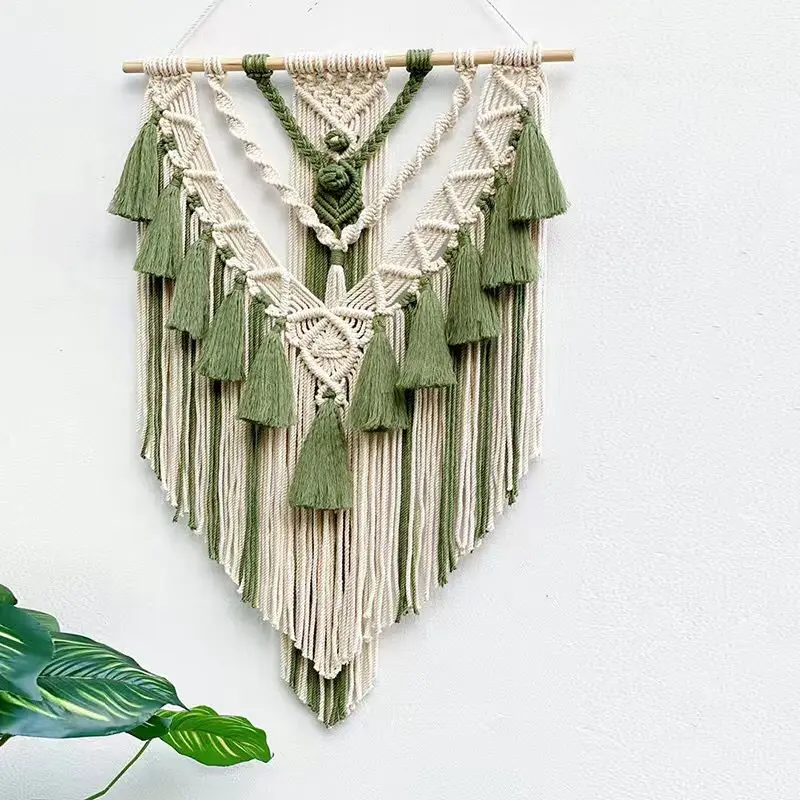
Big Macrame Wall Hanging Green Macrame
This exquisitely handwoven tapestry brings a touch of tranquility and earthy sophistication to any space with its geometric patterns and serene green hues.
Tips for Using Cotton Yarn in Macrame
When venturing into the world of macrame with cotton yarn, the choice of material can profoundly affect the ease of crafting and the quality of the final piece. Here are some curated tips to aid in selecting the right cotton yarn, mastering knotting techniques, and ensuring your projects stand the test of time.
Choosing the Right Cotton Yarn
- Thickness: The thickness of the yarn will significantly impact your project’s overall look and feel. Thicker yarns create bold, chunky designs ideal for statement pieces like wall hangings or plant hangers. In contrast, thinner yarns are perfect for delicate, detailed work, such as jewelry or small ornaments.
- Twist: The twist of the yarn can affect both the texture of your work and its strength. Tightly twisted yarns are stronger and more durable, making them suitable for items that require structural integrity. Loosely twisted or even untwisted (combed) yarns offer a softer appearance and are excellent for projects where a plush, gentle touch is desired.
- Combed vs. Uncombed: Combed cotton yarn is smoother and lends a neat, polished look to your project. Uncombed varieties, on the other hand, offer a raw, textured appeal. Consider the final look you aim to achieve when deciding between combed and uncombed yarn.
Knotting Techniques That Work Well With Cotton Yarn
- Square Knots and Spiral Knots: These are foundational knots in macrame that work exceptionally well with cotton yarn, creating a uniform and clean appearance, integral in designs requiring symmetry and consistency.
- Larks Head and Clove Hitch: These knotting techniques allow for the creation of intricate patterns and textures. Cotton yarn, particularly the softer varieties, is forgiving and flexible, making it easier to adjust and tighten these knots as needed.
- Gathering Knot: Finishing your work with a gathering knot ensures loose ends are secured, and cotton yarn is ideal for creating a smooth and inconspicuous gathering knot due to its softness.
Preventing Fraying and Maintaining Tension
- Sealing Ends: Before beginning your project, lightly apply a clear glue or fray check to the ends of your cotton yarn to prevent fraying. Allow it to dry completely before you start knotting.
- Waxing: For projects that require more rigidity or where you want to minimize fraying significantly, consider lightly waxing the yarn. The wax adds a slight stiffness to the yarn, making it easier to work with and maintain tension.
- Using a Comb: While working with cotton yarn, keeping a fine-toothed comb handy is beneficial. Gently combing through your project as you progress can help in maintaining the yarn’s neatness and prevent tangling, which is essential for keeping consistent tension.
- Adjusting Tension: Cotton yarn is more elastic compared to traditional macrame materials, so it’s crucial to pay attention to the tension you’re applying. Consistent tension ensures an even and professional-looking finish. Practice maintaining a steady hand and adjust the tightness of your knots as you progress.
In conclusion, the success of using cotton yarn in macrame lies in thoughtful selection and handling of the yarn, coupled with mastery over suitable knotting techniques. By following these tips, you can harness the versatility and aesthetic appeal of cotton yarn, creating pieces that are not only beautiful but also structurally sound and lasting.

